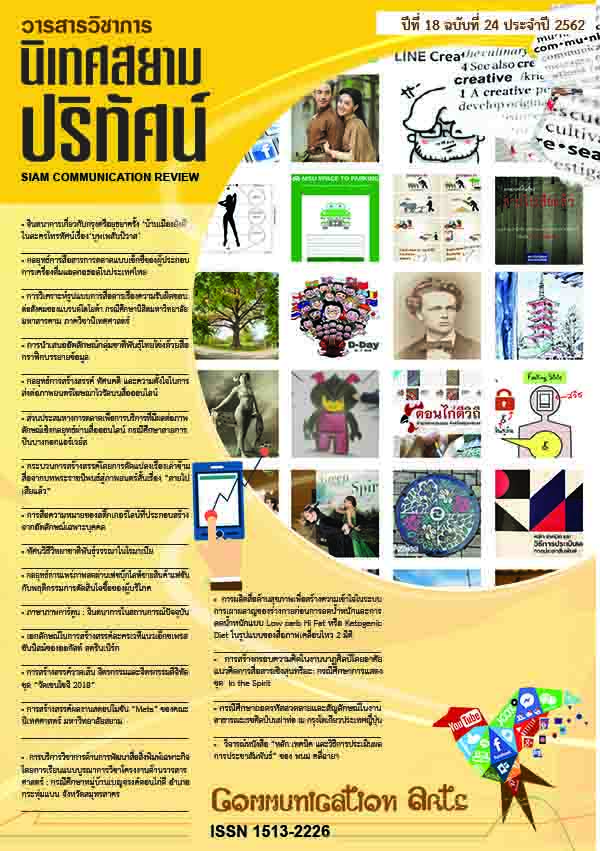จินตนาการเกี่ยวกับกรุงศรีอยุธยา’ครั้งบ้านเมืองดี’ ในละครโทรทัศน์เรื่อง ‘บุพเพสันนิวาส’
Main Article Content
บทคัดย่อ
งานวิจัยเรื่อง “จินตนาการเกี่ยวกับกรุงศรีอยุธยา ‘ครั้งบ้านเมืองดี’ ในละครโทรทัศน์เรื่อง ‘บุพเพสันนิวาส’”ศึกษาความหมายของพื้นที่เชิงจินตนาการในจิตสำนึกของผู้คนโดยเฉพาะโครงสร้างความรู้สึกอันเป็นความหมายเชิงอารมณ์และประสบการณ์ที่เชื่อมโยงความรู้สึกนึกคิดและค่านิยมของกลุ่มคนในปัจจุบันผ่านละครโทรทัศน์ตามกรอบแนวคิดความทรงจำศึกษา ด้วยวิธีวิทยาการเล่าเรื่องจากผู้มีส่วนร่วมในการสร้างสรรค์และผู้ชมละครโทรทัศน์เรื่องบุพเพสันนิวาสจำนวน 5 ท่าน เพื่อศึกษาจินตนาการและอารมณ์ความรู้สึกของผู้คนในสังคมปัจจุบัน 3 มิติ ได้แก่ ภูมิสถานในจินตนาการ ความใฝ่ฝัน และอัตลักษณ์ จากการศึกษาพบว่ากรุงศรีอยุธยาครั้งบ้านเมืองดีเป็นดินแดนในฝันที่หลีกหนีจากความเป็นจริงในชีวิตประจำวัน โดยสะท้อนผ่านภาพวิถีชีวิตริมฝั่งแม่น้ำเจ้าพระยาที่อุดมสมบูรณ์ สวยงาม และสงบสุข ความใฝ่ฝันของผู้คนปรารถนาสังคมในอุดมคติของโลกตะวันออกที่เห็นเด่นชัด 2 ประการ ได้แก่ คติจักรพรรดิราช และคติโลกพระศรีอาริย์ อัตลักษณ์เกิดจากความรู้สึกเชื่อมโยงกับชาติพันธุ์ ชนชั้น และศาสนาร่วมกัน ซึ่งเป็นผลสืบเนื่องมาจาก “เรื่องเล่า” ที่ถูกถ่ายทอดจากมุมมองที่มีเมืองหลวงเป็นศูนย์กลาง จินตนาการร่วมของผู้คนเกี่ยวกับกรุงศรีอยุธยาในละครเรื่องนี้วางอยู่บนฐานความคุ้นชินเกี่ยวกับภาพจำในอดีตตามที่รับรู้ถ่ายทอดกันมา แต่ได้กรองภาพที่เป็นด้านไม่ดีออกเสียหมดคงเหลือไว้แต่เพียงภาพที่ดีงามเพื่อช่วยเยียวยาวิกฤตตัวตนของผู้คนในสังคมปัจจุบัน
Article Details
เอกสารอ้างอิง
กุลยา วิวิตเสวี. (2554). ชาตินิยมในโลกไร้พรมแดน. กรุงเทพมหานคร: สายธาร.
ไชยันต์ รัชชกูล. (2557). ปั้นอดีตเปนตัว. กรุงเทพฯ: อ่าน.
ธงชัย วินิจจะกูล. (2544). “ประวัติศาสตร์ไทยแบบราชาชาตินิยม จากยุคอาณานิคมอำพรางสู่ราชาชาตินิยมใหญ่ หรือลัทธิเสด็จพ่อของกระฎุมพีไทยในปัจจุบัน” ศิลปวัฒนธรรม, 23(1), 56-65.
นิธิ เอียวศรีวงศ์. (2557). การเมืองไทยสมัยพระนารายณ์. กรุงเทพมหานคร: มติชน.
นิธิ เอียวศรีวงศ์. (2557). ชาติไทย, เมืองไทย, แบบเรียนและอนุสาวรีย์ว่าด้วยวัฒนธรรม, รัฐ และรูปการจิตสำนึก. กรุงเทพมหานคร: มติชน.
ประอรรัตน์ บูรณมาตร์. (2528). หลวงวิจิตรวาทการกับบทละครประวัติศาสตร์. กรุงเทพมหานคร: มหาวิทยาลัยธรรมศาสตร์.
เปรมโรจน์ บางอ้อ. (2556). แนวคิดชาตินิยมในแบบเรียนประวัติศาสตร์ระดับชั้นประถมศึกษา ในหลักสูตรแกนกลางการศึกษาขั้นพื้นฐาน พุทธศักราช 2551. วิทยานิพนธ์ปริญญามหาบัณฑิต สาขาวิชาประวัติศาสตร์, มหาวิทยาลัยศรีนครินทรวิโรฒ.
พิมพร สุนทรวิริยกุล. (2558). กระบวนการประกอบสร้างอุดมการณ์ในละครโทรทัศน์ไทยในช่วงภาวะวิกฤตทางการเมือง. วิทยานิพนธ์มหาบัณฑิต ภาควิชาสื่อสารมวลชน คณะนิเทศศาสตร์, จุฬาลงกรณ์มหาวิทยาลัย.
รอมแพง. (2561). บุพเพสันนิวาส. กรุงเทพฯ: แฮปปี้บานานา.
วินัย พงศ์ศรีเพียร. (2534). คำให้การขุนหลวงหาวัดประดู่ทรงธรรม: เอกสารจากหอหลวง. กรุงเทพฯ: คณะกรรมการชำระประวัติศาสตร์ไทยสำนักเลขาธิการนายกรัฐมนตรี.
วิรัช นิยมธรรม. (2551). คิดแบบพม่า : ว่าด้วยชาติและวีรบุรุษในตำราเรียน. มหาสารคาม: สำนักพิมพ์มหาวิทยาลัยมหาสารคาม.
ศรีศักร วัลลิโภดม. (2559). กรุงศรีอยุธยาของเรา. กรุงเทพมหานคร: มติชน.
สายชล สัตยานุรักษ์. (2545). ความเปลี่ยนแปลงในการสร้างชาติไทยและความเป็นไทยโดยหลวงวิจิตรวาทการ. กรุงเทพมหานคร: มติชน.
สุเนตร ชุตินธรานนท์ และคณะ. (2557). ชาตินิยมในแบบเรียนไทย. กรุงเทพมหานคร: มติชน.
เสกสรร ประเสริฐกุล. (2552). รัฐชาติ ชาติพันธุ์ และความทันสมัย. รัฐศาสตร์สาร, 30(พิเศษเล่ม 1), 1-77.
ภาษาอังกฤษ
Bryant, J., & Oliver, M. B. (2009). Media Effects: Advance in theory and research. New York: Routledge.
Erll, A. (2011). Memory in Culture. (Sara B.Young, Trans). London: Palgrave Macmillan.
Fiske, J. (2011). Television culture (2nd Ed.). New York: Routledge.
Lamude, D. (1990). A Cultural Model of Nostalgia and Media Use. World Communication, 19(2), 37-51.
Ott, Brain L. (2007). Nostalgia Television. The Small Screen: How Television Equips Us to Live in the Information Age. Malden, MA: Blackwell Publishing.
Wildschut, T., & Sedikides, C. (2006). Nostalgia: Content, Triggers, Functions. Journal of Personality and Social Psychology, 91(5), 975-993.
ออนไลน์
อรรถจักร สัตยานุรักษ์. (2553). การต่อสู้บนพื้นที่ ‘ความทรงจำ’. เข้าถึงได้จากhttp://www.bangkokbiznews.com/blog/detail/641003


